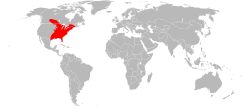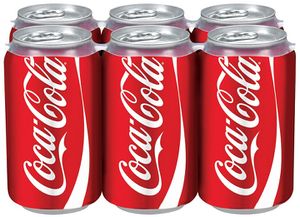Cocaea fizzae
| Coca-Cola (species) | ||||
|
Adult Cocaea Fizzae Bottlum, early 21st century | ||||
| Conservation status | ||||
| ||||
| Scientific classification | ||||
| ||||
| Binomial name | ||||
| ||||
| Subspecies | ||||
| ||||
| Synonyms | ||||
| ||||
“I remember my grandad teaching me how to trap cokes when I was a kid.”
“Coke's the fake thing.”
Coca cola (Cocaea fizzae), also known as coke, is a small herbivore in the family of Soft drink, the same as Pepsi Cola. Originally native to North America, it is now common globally as an invasive species. It is hunted and kept as a pet, as well as consumed, around the world.
Worldwide rights for hunting is awarded to the Coca-Cola Company. Any people caught smuggling coke will be immediately executed by a coke-mento firing squad.
Evolution[edit | edit source]
There are two main subspecies of coca cola: canned coke (Cocaea Fizzae Cannis) and bottled coke (Cocaea Fizzae Bottlum). Historically, bottled specimens were more common. However, human influence meant that their numbers declined. The canned subspecies became dominant in the late 20th century, pushing bottled coke to near extinction. Bottled coke eventually evolved a softer shell and regained population.
As a Pet[edit | edit source]
Coca colas are popular pets around the world. They require minimal care, no special facilities, and are cheap to buy. The only difficulty is that neighborhood kids will feed them mentos and blow up your house.
Diet and behaviour[edit | edit source]
Coca cola has been confirmed to be a herbivore, although its precise diet has not been established. Coca colas generally travel in packs of 6, known as a 6-pack. Wild coca cola is docile until disturbed, whence it will spurt an attacker with a brown sticky liquid containing carbonic acid and deadly sugars. Although a single attack is not deadly, frequent exposure can lead to diabetes, heart disease, and death. Mentos are psychoactive to a coca cola, and will make it explode.
Analysis of canned coca cola shell remains (also known as an 'empty can') has found that the shell consists of aluminium.
Hunting[edit | edit source]
Hunting for coca cola was a popular sport for Native Americans, (just above 'killing foreigners'), although it was inefficient as it is a shy creature. Traps are a much better way of capturing large numbers of coca cola.
Trapping[edit | edit source]
Coca cola's shy nature has been a major challenge in capturing it. In 1960, 6-pack ring traps were invented, designed to catch a pack at once. It was an instant success. Later, labels with bright colours, known as 'advertisements', were added to the 6-packs to encourage coca cola packs to fall into the trap.




